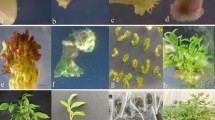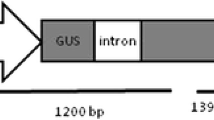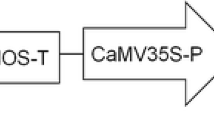Abstract
An Agrobacterium tumefaciens-mediated genetic transformation system was successfully developed for white ash (Fraxinus americana) using hypocotyls as the initial explants. Hypocotyls isolated from mature embryos germinated on Murashige and Skoog (MS) medium supplemented with 22.2 µM 6-benzyladenine (BA) and 0.5 µM thidiazuron (TDZ) were transformed using A. tumefaciens strain EHA105 harboring the binary vector pq35GR containing a fusion gene between neomycin phosphotransferase (nptII) and gusA, as well as an enhanced green fluorescent protein (EGFP). Explants were transformed in a bacterial suspension with 100 µM acetosyringone using 90 s sonication and 10 min vacuum infiltration. Putative transformed shoots representing seven independent lines were selectively regenerated on MS medium with 22.2 µM BA, 0.5 µM TDZ, 50 mg L−1 adenine sulfate, 10 % coconut water, 30 mg L−1 kanamycin, and 500 mg L−1 timentin. Timentin at 500 mg L−1 was optimal for controlling excess bacterial growth, and transformed shoots were selected using 30 mg L−1 kanamycin. The presence of GUS (β-glucuronidase), nptII, and EGFP in transformed plants was confirmed by polymerase chain reaction (PCR). Reverse transcription-PCR and fluorescence microscopy confirmed the expression of EGFP. Transgenic microshoots were rooted (80 %) on woody plant medium supplemented with 4.9 µM indole-3-butyric acid, 2.9 µM indole-3-acetic acid, and 500 mg L−1 timentin, and subsequently acclimatized to the culture room. This transformation protocol provides the framework for future genetic modification of white ash to produce plant material resistant to the emerald ash borer.







Similar content being viewed by others
References
Andrade GM, Nairn CJ, Le HT, Merkle SA (2009) Sexually mature transgenic American chestnut trees via embryogenic suspension-based transformation. Plant Cell Rep 28:1385–1397
Bates SA (1997) Developing protocols to genetically transform white ash (Fraxinus americana L.). Dissertation, Southern Illinois University at Carbondale
Bauer LS, Londoño DK (2011) Effects of Bacillus thuringiensis SDS-502 on adult emerald ash borer. In: McManus KA, Gottschalk KW (eds) 2010 Proceedings 21st USDA interagency research forum on invasive species, GTR-NRS-P-75, pp 74-75
Cheng ZM, Schnurr JA, Kapaun JA (1998) Timentin as an alternative antibiotic for suppression of Agrobacterium tumefaciens in genetic transformation. Plant Cell Rep 17:646–649
Dobesberger EJ (2002) Emerald ash borer, Agrilus planipennis: pest risk assessment. Canadian Food Inspection Agency Plant Health Risk Assessment Unit, Nepean
Du N, Pijut PM (2009) Agrobacterium-mediated transformation of Fraxinus pennsylvanica hypocotyls and plant regeneration. Plant Cell Rep 28:915–923
Duan JJ, Bauer LS, Gould JR, Lelito JP (2012) Biological control of emerald ash borer in North America: current progress and potential for success. IOBC-NRS-Newsletter 34: 5
Emerald Ash Borer Information Website (2014). http://www.emeraldashborer.info. Accessed 30 April 2014
Forest Products Laboratory (2010) Wood handbook—Wood as an engineering material. Gen Tech Rep FPL-GTR-190. Madison, WI: U.S. Dept. of Agriculture, Forest Service, Forest Products Laboratory. 508 p
Gamborg OL, Miller RA, Ojima K (1968) Nutrient requirements of suspension cultures of soybean root cells. Exp Cell Res 50:151–158
Gonzalez Padilla IM, Webb K, Scorza R (2003) Early antibiotic selection and efficient rooting and acclimatization improve the production of transgenic plum plants (Prunus domestica L.). Plant Cell Rep 22:38–45
Hahn J, Herms DA, McCullough DG (2011) Frequently asked questions regarding potential side effects of systemic insecticides used to control emerald ash borer. www.emeraldashborer.info. Accessed 30 April 2014
Herms DA, McCullough DG (2014) Emerald ash borer invasion of North America: history, biology, ecology, impacts, and management. Annu Rev Entomol 59:13–30
Jefferson RA, Kavanagh TA, Bevan MW (1987) GUS fusions: β-glucuronidase as a sensitive and versatile gene fusion marker in higher plants. EMBO J 6:3901–3907
Johnston JWJ (1939) The soil fauna in mor and mull soils under white pine and succeeding hardwoods. Soils For Confec Proc 1939:6–8
Kim MS, Klopfenstein NB, Cregg BM (1998) In vitro and ex vitro rooting of micropropagated shoots using three green ash (Fraxinus pennsylvanica) clones. New For 16:43–57
Knight KS, Brown JP, Long RP (2012) Factors affecting the survival of ash (Fraxinus spp.) trees infested by emerald ash borer (Agrilus planipennis). Biol Invasions 15:371–383
Kovacs KF, Haight RG, McCullough DG, Mercader RJ, Siegert NW, Liebhold AW (2010) Cost of potential emerald ash borer damage in US communities, 2009–2019. Ecol Econ 69:569–578
Lefort F, Douglas GC (1999) An efficient micro-method of DNA isolation from mature leaves of four hardwood tree species Acer, Fraxinus, Prunus, and Quercus. Ann Des Sci Forestières 56:259–263
Li ZJ, Jayasankar S, Gray DJ (2004) Bi-directional duplex promoters with duplicated enhancers significantly increase transgene expression in grape and tobacco. Transgenic Res 13:143–154
Liu X, Feng CM, Franks R, Qu R, Xie DY, Xiang QYJ (2013) Plant regeneration and genetic transformation of C. canadensis: a non-model plant appropriate for investigation of flower development in Cornus (Cornaceae). Plant Cell Rep 32:77–87
Lloyd G, McCown B (1981) Commercially feasible micropropagation of mountain laurel, Kalmia latifolia, by use of shoot-tip culture. Proc Int Plant Prop Soc 30:421–427
MacFarlane D, Meyer S (2005) Characteristics and distribution of potential ash tree hosts for emerald ash borer. For Ecol Manag 213:15–24
McCullough DG, Schneeberger, NF, Katovich SA (2008) Pest alert: emerald ash borer. USDA Forest Service State, Northeastern Area State and Private Forestry, NA-PR-02-04. www.na.fs.fed.us. Accessed 30 April 2014
Murashige T, Skoog F (1962) A revised medium for rapid growth and bio assays with tobacco tissue cultures. Physiol Plant 15:473–497
Nesom G (2001) Plant guide: white ash, Fraxinus americana L. USDA Natural Resources Conservation Service. https://plants.usda.gov/plantguide/pdf/cs_fram2.pdf. Accessed 30 April 2014
Palla KJ, Pijut PM (2011) Regeneration of plants from Fraxinus americana hypocotyls and cotyledons. In Vitro Cell Dev Biol-Plant 47:250–256
Poland T, McCullough D (2006) Emerald ash borer: invasion of the urban forest and the threat to North America’s ash resource. J For 104:118–124
Roome WJ (1992) Agrobacterium-mediated transformation of two forest tree species Prunus serotina and Fraxinus pennsylvanica. Thesis, State University of New York, College of Environmental Science and Forestry
Satchel SE, Messens E, Van Montagu M, Zambryski PC (1985) Identification of the signal molecules produced by wounded plant cell that activate T-DNA transfer in Agrobacterium tumefaciens. Nature 318:624–629
Schlesinger RC (1990) Fraxinus americana L white ash. In: Burns RM, Honkala BH (eds) Silvics of North America. Vol 2 Hardwoods. USDA Forest Service Agric Handbook 654, Washington pp 333–338
SPSS Inc (2011) SPSS for Windows. Chicago, IL. Ver 20
Stevens ME, Pijut PM (2014) Agrobacterium-mediated genetic transformation and plant regeneration of the hardwood tree species Fraxinus profunda. Plant Cell Rep. doi:10.1007/s00299-014-1562-2
Subramanyam K, Subramanyam K, Sailaja KV, Srinivasulu M, Lakshmidevi K (2011) Highly efficient Agrobacterium-mediated transformation of banana cv. Rasthali (AAB) via sonication and vacuum infiltration. Plant Cell Rep 30:425–436
Sun Q, Zhao Y, Sun H, Hammond RW, Davis RE, Xin L (2011) High-efficiency and stable genetic transformation of pear (Pyrus communis L.) leaf segments and regeneration of transgenic plants. Acta Physiol Plant 33:383–390
Wallander E (2008) Systematics of Fraxinus (Oleaceae) and evolution of dioecy. Plant Syst Evol 273:25–49
Yang M, Mi D, Ewald D, Wang Y, Liang H, Zhen Z (2006) Survival and escape of Agrobacterium tumefaciens in triploid hybrid lines of Chinese white poplar transformed with two insect-resistant genes. Acta Ecologica Sinica 26:3555–3561
Yu CM (1992) Agrilus marcopoli Obenberger. In: Xiao GR (ed) Forest insects of China. China Forestry Publishing House, Beijing, pp 400–401
Acknowledgments
The authors gratefully acknowledge Drs. Zong-Ming (Max) Cheng, Manjul Dutt, and Vibha Srivastava for their constructive review and suggestions for the improvement of this manuscript. The authors would also like to acknowledge Dr. Jody Banks (Purdue University) for use of the fluorescence stereomicroscope and Dr. Dennis J. Gray (University of Florida) for the transformation vector pq35GR. This research was supported by a Fred M. van Eck scholarship for Purdue University to Kaitlin J. Palla, with partial funding from the U.S. Department of Agriculture-Animal and Plant Health Inspection Service-Plant Protection and Quarantine-Center for Plant Health Science and Technology. Mention of a trademark, proprietary product, or vendor does not constitute a guarantee or warranty of the product by the U.S. Department of Agriculture and does not imply its approval to the exclusion of other products or vendors that also may be suitable.
Author information
Authors and Affiliations
Corresponding author
Rights and permissions
About this article
Cite this article
Palla, K.J., Pijut, P.M. Agrobacterium-mediated genetic transformation of Fraxinus americana hypocotyls. Plant Cell Tiss Organ Cult 120, 631–641 (2015). https://doi.org/10.1007/s11240-014-0630-1
Received:
Accepted:
Published:
Issue Date:
DOI: https://doi.org/10.1007/s11240-014-0630-1




